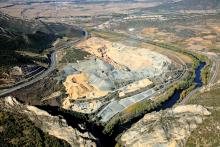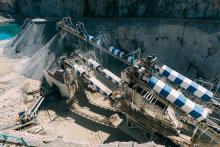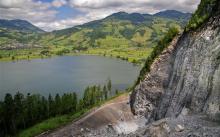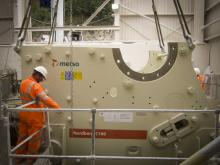
A prominent German aggregates producer is in the frame to capitalise on rising local demand for building materials after a major primary crusher station upgrade. Guy Woodford reports.
Jakob Bauer Söhne GmbH & Co. KG (Jakob Bauer Söhne) based in Erkenbrechtsweiler, near Stuttgart, southern Germany, has been processing White Jura rock from the Swabian Alb since the 1920s.
The company’s gravel plant produces chippings and gravel for road construction and maintenance, with the same site also renowned for its concrete chips for tunnel construction. Jakob Bauer Söhne’s most common gravel product sizes are on average 2-8mm, 8-16mm and 16-22mm. As large construction sites are practically on the company’s doorstep, current local demand for quality aggregates is very high.
“Stuttgart 21, the Stuttgart-Ulm rapid-transit railway and the Bossler tunnel are just a few projects in which our concrete aggregates are used,” explains plant manager Siegfried Militsch.
The Jakob Bauer Söhne product sales team work together with Alfred Moeck KG, Steinbruch und Schotterwerk, via the jointly founded Schottervertrieb Vordere Alb GmbH & Co. KG (SVA ).
In late 2017, the Erkenbrechtsweiler plant’s management decided to improve the pre-crushing process within the primary crusher station, replacing a stationary integrated excavator with a more flexible mobile mini excavator equipped with a hydraulic hammer. A new monitoring cage was also installed.
During this period, it was also noticeable that the plant’s old jaw crusher had cracks around its inlet. This initially did not surprise Siegfried Militsch and his colleague Uwe Laderer, as millions of tonnes of rock had already been fed to the crusher over several decades. However, closer inspection also revealed cracks below the inlet opening. This level of damage had not been expected.
The former manufacturer of the stationary primary crusher explained that a repair would only be possible if the crusher was removed from its steel housing within the primary crusher station and brought to the factory for the necessary welding work. This, however, provided the impetus for further reflection.
It was decided to optimally design the inlet width of the new jaw crusher in relation to the outlet width of the roller grate for the feed material. A crusher with 120-125cm inlet width was agreed on. Prior to this, however, it was necessary to examine whether the integration of a new jaw crusher in the crusher’s existing steel housing would be possible under the given circumstances. When it was finally determined that the outer girders of the steel housing still provided “air” for positioning and thus room for a wider stationary crusher, the decisions could be made accordingly.
The favoured option was a
The subsequent commissioning of the new jaw crusher went smoothly. The model is said to be running continuously and highly efficiently, relieving pressure on the impact crusher used in the latter stage of production. Overall, plant parts wear has also been significantly lower since the Nordberg C125 unit’s installation.
With minerals cultivation areas still available to Jakob Bauer Söhne GmbH & Co. KG for the next 20 years, the company’s investment in Metso technology has left it well set to explore new commercial opportunities.










